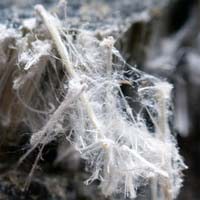Asbestos Preparation Impacts Mesothelioma Risk
 There is new evidence that how asbestos fibers are prepared for use can have an impact on their ability to trigger asbestos-related diseases such as asbestosis, lung cancer, and malignant mesothelioma.
There is new evidence that how asbestos fibers are prepared for use can have an impact on their ability to trigger asbestos-related diseases such as asbestosis, lung cancer, and malignant mesothelioma.
Asbestos is a naturally occurring mineral that is ground up for use in a variety of industrial and construction applications.
Researchers at the University of Pennsylvania recently found that asbestos that is ground while dry, rather than ground with water, contains 7 times more iron than wet-ground asbestos, potentially making it even more likely to cause deadly mesothelioma.
Asbestos and Mesothelioma
Before asbestos was linked to peritoneal and pleural mesothelioma in the early part of the 20th century, asbestos was prized for its strength and ability to resist heat, fire and corrosion.
But after industrial workers and miners who handled asbestos and asbestos-containing products began to receive mesothelioma diagnoses in the decades after their exposure, asbestos was revealed to be a highly-toxic substance and was banned in many countries.
How Toxic is Asbestos?
To measure the toxicity of asbestos fibers prepared in different ways, the Penn team ground chrysotile ore with or without water for 5 to 30 minutes.
The resulting fibers were applied to macrophages, a type of immune system cell, taken from the peritoneal membranes of mice. The peritoneum is the membrane that surrounds the abdominal organs and is the site of peritoneal mesothelioma.
The macrophages reacted more negatively to the dry-ground fibers than the wet-ground, producing more reactive oxygen species, molecules which may play a role in the development of lung cancer and mesothelioma. The scientists say the difference is iron.
“These results indicate that grinding methods significantly affect the surface concentration of iron, resulting in changes in fiber-induced reactive oxygen species generation or toxicity,” writes author Ashkan Salamatipour with the Division of Pulmonary, Allergy and Critical Care Medicine at Penn.
Asbestos Toxicity and Mesothelioma
Scientists are still not entirely sure how asbestos triggers malignant mesothelioma, but the high concentration of iron in asbestos ore is believed to be a factor. The size and shape of asbestos fibers make it difficult for the body to rid itself of the toxin once it has been inhaled or ingested, holding the excess iron in place and raising the risk of cancers like mesothelioma.
To get a clearer picture of just how dangerous asbestos really is, the University of Pennsylvania researchers say asbestos fiber preparation techniques should be considered when comparing asbestos toxicity studies to one another.
Source:
Salamatipour, A, et al, “Asbestos Fiber Preparation Methods Affect Fiber Toxicity”, July 12, 2016, Environmental Science & Technology Letters, pp. 270-274





